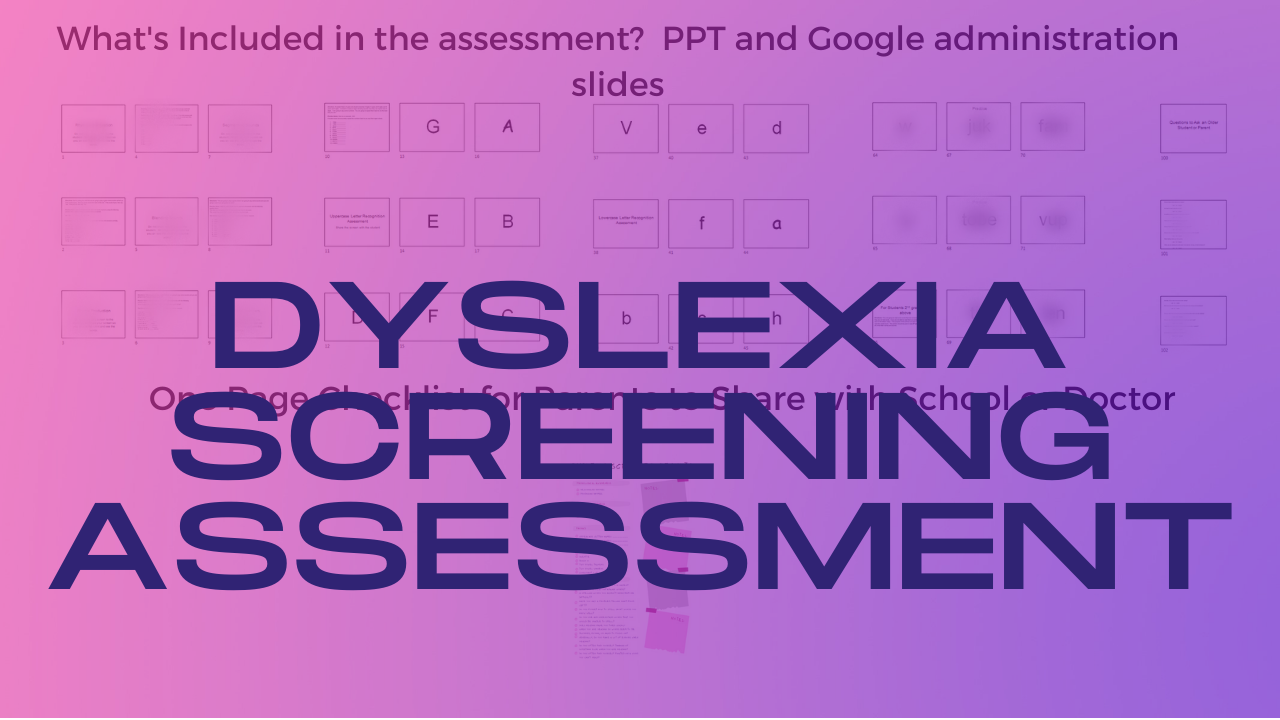
You get a new student and can’t wait to start tutoring. As time goes on, you realize there may be some other things hindering their success.
You wonder if dyslexia could be impeding this child’s success, but the parent has made no mention of a dyslexia diagnosis.
As a tutor what do you do?
Ignore the signs?
Or dive a little deeper.
Dyslexia impacts 1 in 5 children. That is 20% of the population.
40 million people in the US have dyslexia, but only 2 million have been diagnosed. Our school system is abysmal at diagnosing this learning difference and some schools still deny that dyslexia exists.
That is why I saw a need to create a dyslexia screening assessment that would give tutors the data they need to begin giving appropriate instruction. Then we can give the data to a parent and share with them the next steps in getting diagnosed if they wish to pursue it.
Some Parents do not Want Their Child Labeled
Every parent has the right to have their child diagnosed.
I have personally worked with many parents who feel getting their child labeled as dyslexic will mean having their child treated differently. Some parents don’t want their child to be pulled out of class and are not aware of the benefits of getting diagnosed.
These parents also want to avoid the stigma that having dyslexia means you can’t read or are dumb.
These parents are smart enough to know that their child can learn to read, it may just take a little bit longer.
School Systems Limit How Quickly Kids Can Read
Often kids that are diagnosed with dyslexia in the school system are given a one size fits all approach. These kids are placed in group classes instead of given one on one attention.
This is exactly why I created the dyslexia screening assessment for tutors. We can speed up the process with how quickly kids can learn to read. If we find out exactly where the gaps are, we can identify those gaps and close the gaps allowing kids to feel more confident even if a parent does not choose to get a full diagnosis of dyslexia.
Want to know if your student is at risk for dyslexia? Use this screener to determine what needs to be specifically taught and inform the parent of the next steps.
What’s Included in the Dyslexia Screening Assessment
Dyslexics struggle with phonological awareness. There is a rhyming assessment to find out if the child can rhyme. Next, you want to dive into phonemic awareness. This part of the assessment has phoneme blending and segmenting.
After that, you will dive into letter names and sounds. Often kids that have dyslexia have had a hard time remembering the names and sounds of the letters even if their parents have spent years helping them. After a time, sounds that are not used often can be a source of confusion. For example, many kids with dyslexia will say the sound for y is /w/. Dyslexics confuse the beginning of the letter name as the sound. Beginning readers and dyslexic kids make the wrong association and use it to help figure out the sound.

Many dyslexics struggle with sequencing. The next part of the screening has the child list numbers that have been spoken. A typical 4-year-old can repeat back a sequence of 4 numbers. A 5-year-old can repeat back 5 numbers and a 6-year-old 6 numbers. The typical adult can repeat back 7 numbers. This is why phone numbers were given 7 digit numbers.
The next part of the assessment is for kids that are in 2nd grade or above. This part has kids read words that are not real words, also known as nonsense words. Nonsense words follow the phonics patterns to see how kids do with reading unknown words. Through this activity, you can determine which patterns need to be taught. This allows you to fast forward the instruction and not have to start at the beginning of phonics instruction.
I have created a PowerPoint/Google Slide for you to administer the test to the child and a tracking sheet where you can write down the results. There is a video that shares exactly how to use these resources.
Lastly, there is a one-page checklist that you can share with the parent. The parent can share this form with the school or their doctor if they choose to get further testing done.
The best part is, even if the parent doesn’t get testing done, you have all the data you need to instruct the child. You now know if you need to teach phonological awareness, phonemic awareness, and phonics. You know exactly what letter sounds the student knows and which ones you need to continue to teach.
How to Talk to the Parents About the Results
As a tutor, you do not have enough information to come to the conclusion that a child is dyslexic. When you talk to the parents it is important that they understand this. Dyslexia is a medical diagnosis and you still need an IQ test, memory and processing speeds, oral language, written language, reading comprehension, social and motor skills. To learn more about these assessments, check out the dyslexia help website.
You may say to a parent that you gave a screener so that you would know which skills you need to focus on to help close the gap. It is your suggestion that they take this information to the school or to their pediatrician to get further testing. You can end the discussion at this point. No need to continue unless the parent asks you additional questions.
Pros and Cons of Getting Diagnosed
As with anything, there are pros and cons to getting diagnosed. Some people are relieved to find out that they have dyslexia. To be diagnosed with dyslexia you have to have a high IQ. Contrary to popular belief that you are dumb if you struggle with reading, dyslexics are creative and problem solvers.
Some parents want to avoid the stigma of a label and this needs to be respected. These parents want to protect their children from teasing and bullying that may occur.

If a parent wishes to know the pros of getting a diagnosis you can share that there are some reading programs that are more effective and extra help at school may be provided. Also, when a dyslexic takes any timed test, the time restrictions are removed giving them an opportunity to do well. This is helpful not only on state tests but also on the SAT/ACT and any tests that are given in college.
Final Thoughts
People with dyslexia are not dumb, they just need more time to learn how to read. These kids need direct instruction with phonics, time reading real text and patient adults who can guide and help. Dyslexics can learn to read it may just take a little more time.
Early identification and early intervention are the keys to helping dyslexic children. The longer you wait the tougher it gets. As my friend Amy Janjgava says, “Getting help early is the difference between a crack and a canyon.” If we help to close the gaps early everything else becomes easier over time.
Dyslexia never goes away. Get the Dyslexia Screening Assessment today and begin helping your students close those gaps, increase their confidence, and avoid undue stress.
Want to learn how to get students for your tutoring business?
Download 50 + Ways to Get Online Tutoring Students.

